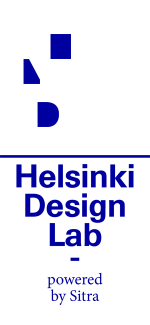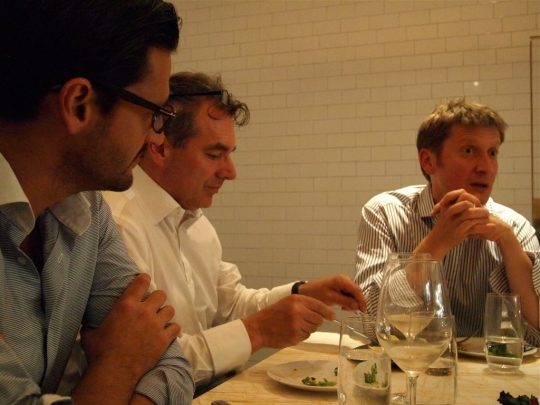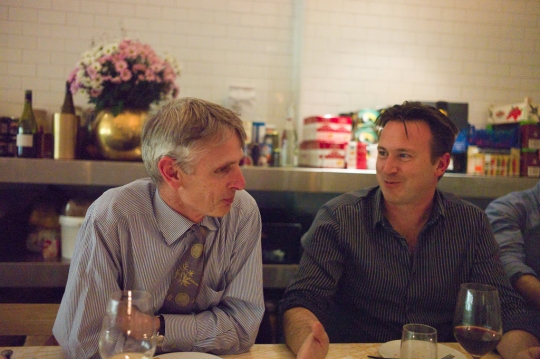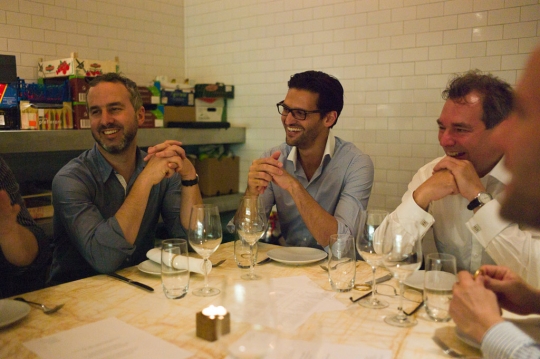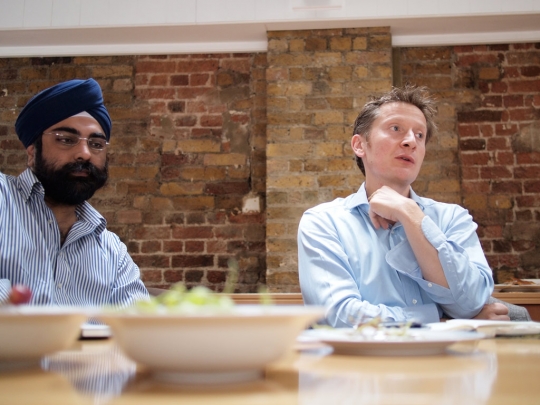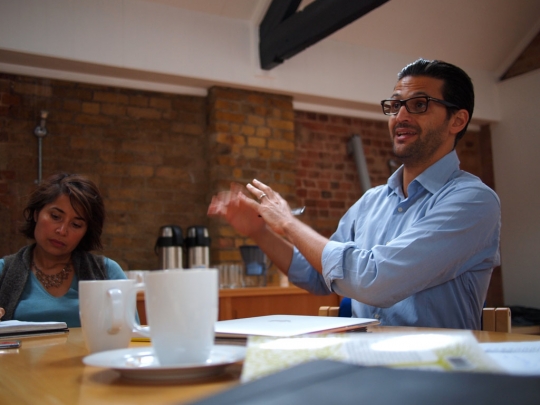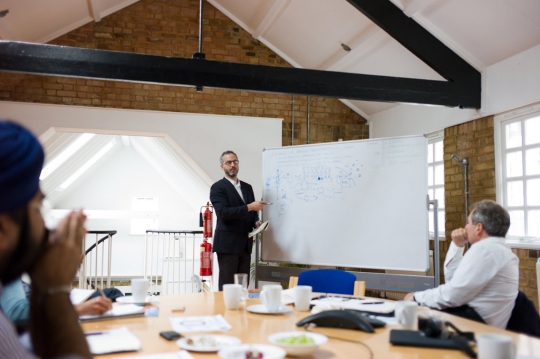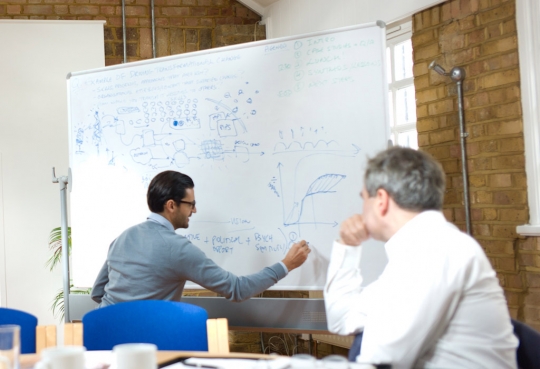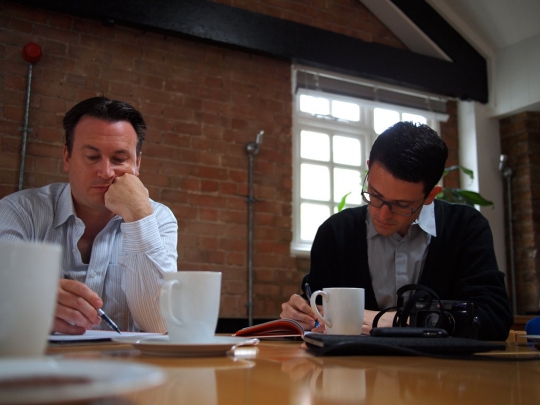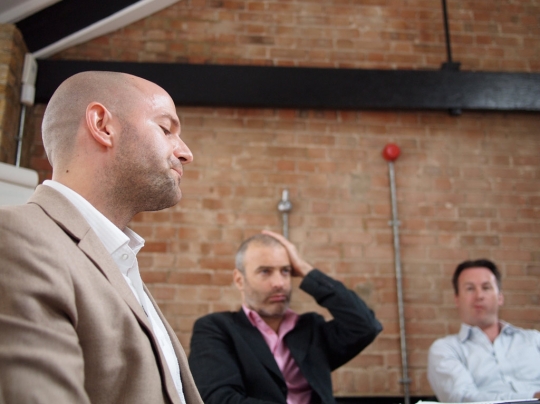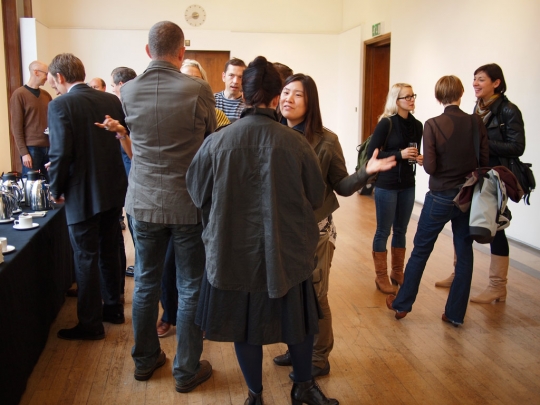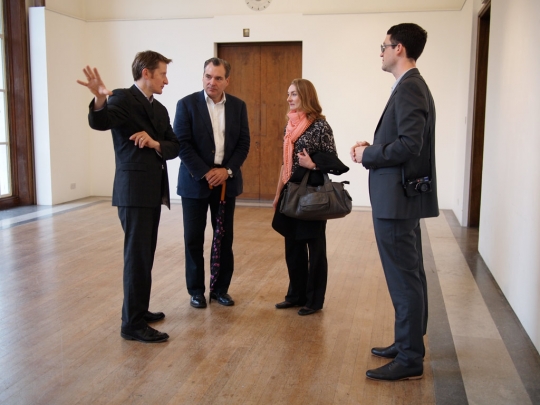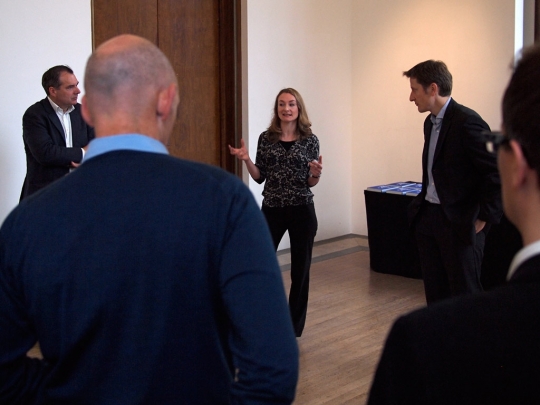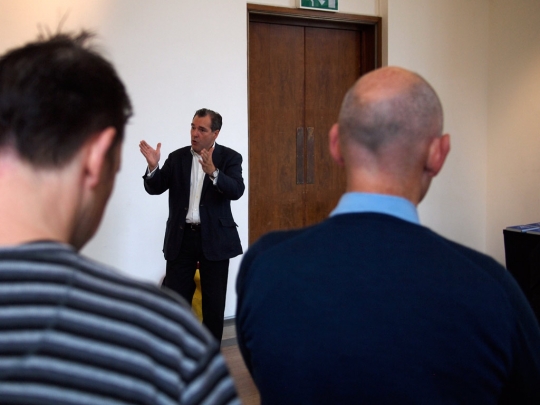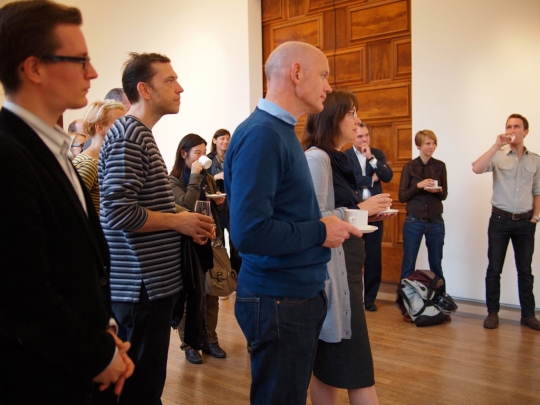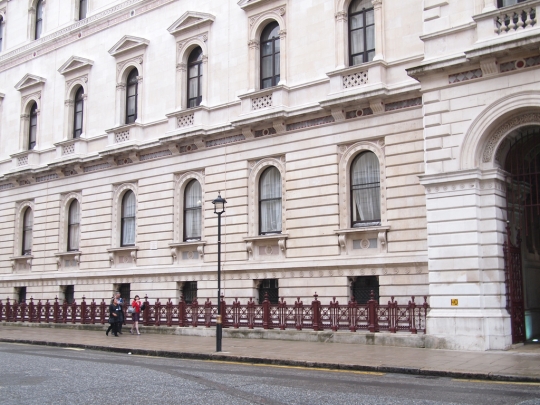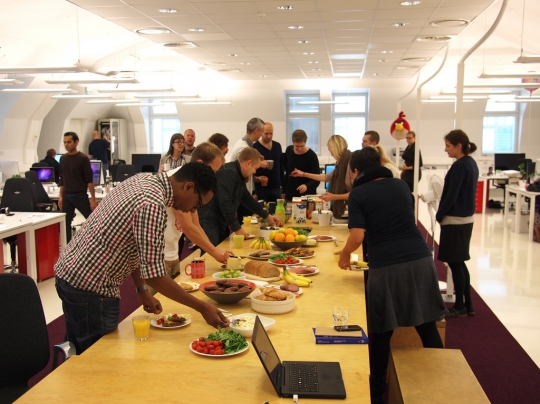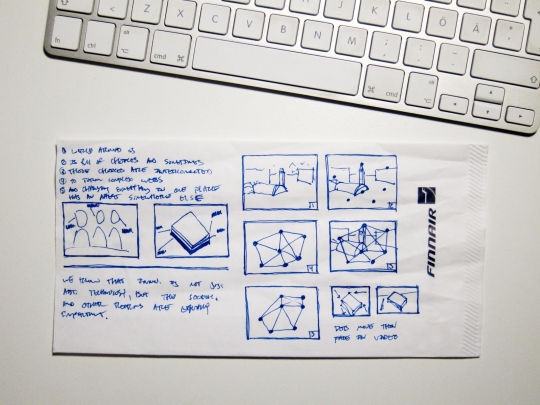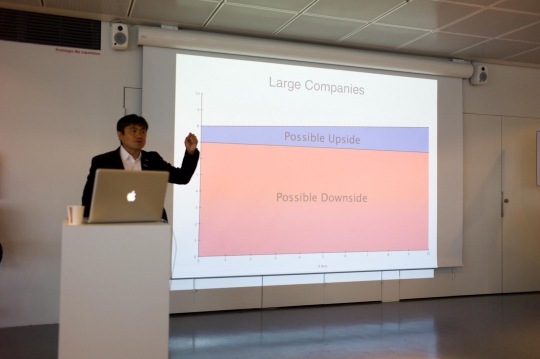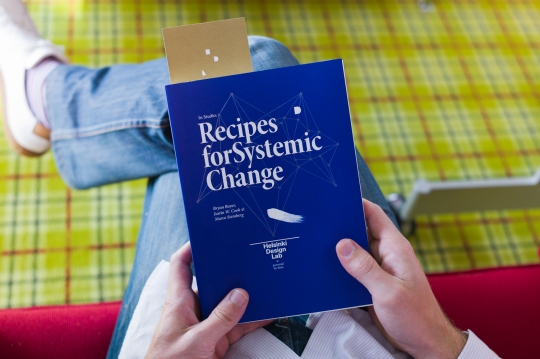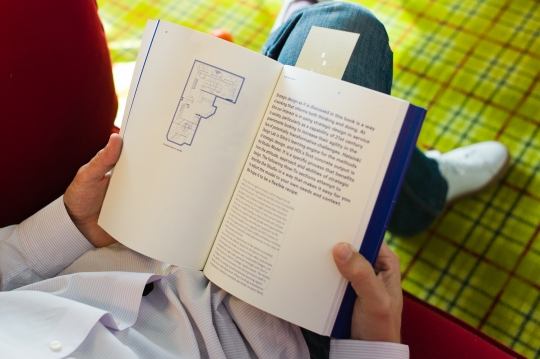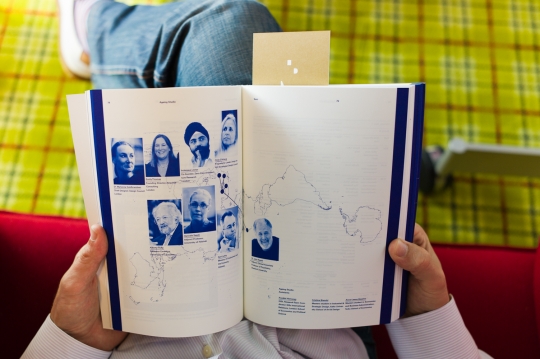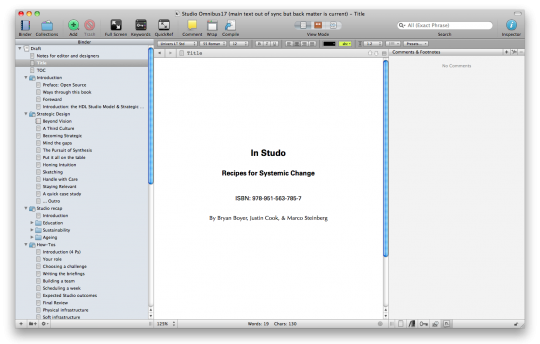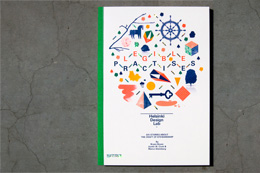All posts tagged In Studio
This week's diaries look much the same as last week's. Another launch event for the HDL In Studio book, but this time in London.
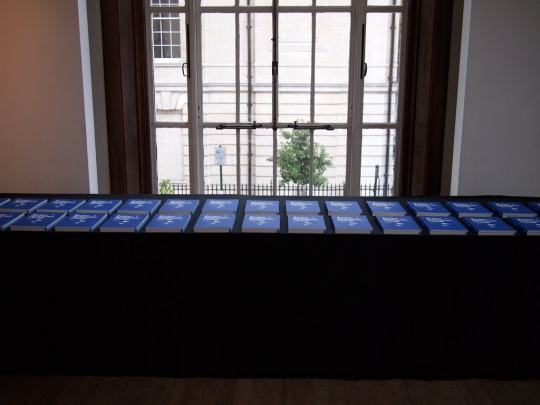
HDL In Studio books waiting to be launched.
Before the launch though, Bryan, Marco and I take part in a roundtable on 'getting systemic change done'. We'd jointly organised the event with E3G, who hosted it at their Southwark HQ. We actually started on Monday night, pulling most of the participants together for dinner. (We often like to use this tactic of the-dinner-the-night-before; it breaks the ice in a natural, convivial way rather than through some dreadful exercise in which people are forced to suggest what kind of animal they would be if indeed they were an animal. It also enables people to tentatively pitch a starting position and rehearse some of the conversation. And it means you can hit the ground running in the morning. Plus, it's dinner.)
And Tuesday was excellent. Participants included Alejandro Litovsky from Earth Security Initiative, Sam Bickesteth from Climate and Development Knowledge Network, Kipper Blakely from Social Investors, 00/The Hub's Indy Johar, E3G's Nick Mabey, Malini Mehra from Centre for Social Markets, Peter Sharratt from Deloitte, and Dimitri Zhengelis from Cisco/LSE Cities. It was a long but fruitful day, with the morning spent presenting and comparing case studies, and the afternoon spent poring over the common ground.
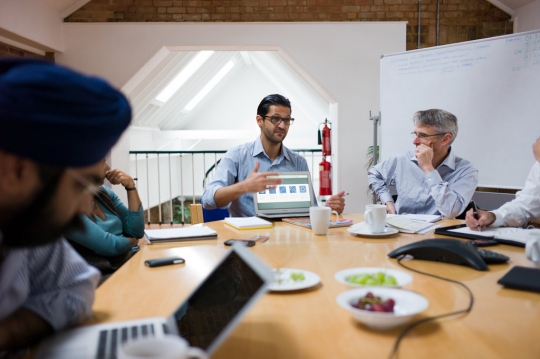
We banned Powerpoint for this session, but made a small exception for Alejandro's diagram.
With much of the group talking about inspirational change projects around climate change, sustainability and government, often from the context of exerting change from 'outside' a system, I decided to present a contrast, talking about my work at the BBC, around the iPlayer on-demand media service. This was a form of design work conducted from deep inside an organisation; sometimes instinctive, sometimes tactical, sometimes strategic.
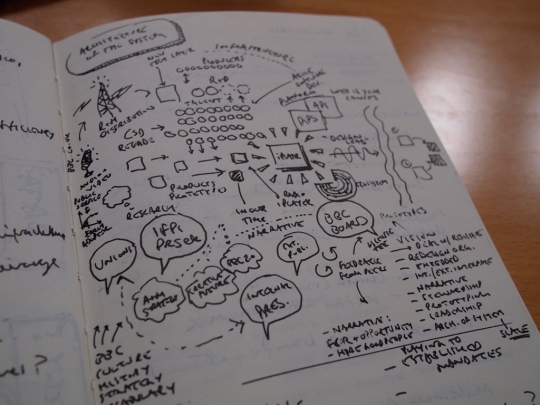
Notebook sketch of iPlayer 'architecture of the problem'.
This preparatory sketch from my notebook, scribbled over breakfast, really represents the tip of the iceberg in terms of design of both context and product. I transferred the diagram to the whiteboard as I told the story, in order to give a sense of how messy, complex and multi-dimensional this embedded design work can be. I never thought of it as "strategic design" at the time, and indeed though it's quite different to much of the work now, there are many shared elements—not least as these services do represent a form of systemic change, albeit with different purpose.
Ultimately, this was a demonstration of understanding 'the architecture of the problem', as we would now call it, or how contemporary media works as a system (see some earlier thinking about how contemporary media works) and how that connects to organisations and culture. This was beyond editorial concerns; that the design of media systems and organisations themselves was the strategic act that would alter the greater system.
Indeed, though it was a deliberate choice as contrast, what was interesting in the morning's discussion was seeing how much commonality there was between case studies and discussions. The others round the table presented some fascinating projects, ranging from the UK's Green Infrastructure Bank to The Hub project, via case studies from South Africa, India, Thailand, UAE, Argentina and of course Finland.
Much to chew on, and we're looking to develop that and other discussions over the next few months. As this territory is yet to be coherently mapped, we draw a lot from these conversations.
We launched the HDL In Studio book at the Royal Institute of British Architects (RIBA) on Wednesday morning. We had a good gathering for coffee and korvapuusti (Finnish cinamon buns, sourced from the Nordic Bakery in Marylebone via Bryan!).
Marco gave an introduction and hosted a discussion with Peter Sharratt, an architect and sustainable development leader now working at Deloitte, and Marianne Guldbransen, Head of Design Strategy at the UK's Design Council.
Our books disappeared faster than the korvapuusti, which is surely a good sign.
As a self-indulgent sidenote, it was a particular pleasure to be back at RIBA. When I was at the BBC, based at Broadcasting House down the road, we would often use the place for awaydays and meetings of all kinds; plus, it was a favourite 'hiding place' from my team when I needed to get some concentrated work done. (Sorry team.) It's a wonderful space.
After the launch, we hot-foot it across town to Whitehall, accompanied by NESTA's Laura Bunt, to visit the UK government, with whom we swapped notes in another fascinating, thought-provoking session. This was followed by lunch and more productive note-swapping (a theme of the week) at the Institute for Government in Carlton Gardens.
The rest of the week was spent back in Helsinki, keeping various projects ticking over. I gave a talk at Fjord Helsinki on Friday morning (thanks for the invite, Fjord!) on various aspects of our work. It was good to see their team, and their space. Their regular Friday morning shared-breakfast-at-long-table-plus-talk will be something I'll take into our conversations at Sitra, concerning our future workspace.
I also met a local researcher (via Demos Helsinki—ta!) who we'll ask to unpack some food supply chains for us. I've been working on a briefing document around food culture in Finland, and a diagram laying out just how, say, a hot dog emerges on a Helsinki street corner late one night will probably be particularly interesting.
Justin and Bryan have been knee-deep in re-launching the Low2No website (Low2No is one of our key 'systemic change' projects, predicated on building a new neighbourhood in Helsinki.) Do take a look and have a poke around; there's lots of new material and a sharper design to help you find it (which will be familiar to users of this site.) We're starting to carefully pick apart the difference between the block and the model (watch for some forthcoming writing on this 'hook/trojan horse' approach) as well as some curated contributions unpacking the idea of sustainable cities in general.
For instance, read the essay by Federico Parolotto and Francesca Arcuri of Mobility in Chain on sustainable mobility. I had the pleasure of working with Federico in last year's 'zero-carbon Finland' HDL studio, and it's always interesting to hear Mobility In Chain's thoughts on these issues.
Finally, Marco has been hard at work setting up our third major project area, alongside HDL and L2N. Known internally as 'Exchange' at the moment, we'll reveal more of this as it emerges, but suffice to say it should test a new and important angle for our work. Pretty exciting if it comes off. More later.
When the calendar looks like this you know it's going to be a steamroller of a week.
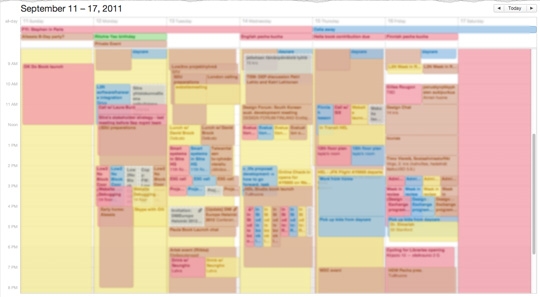
Names blurred to protect the innocent
The easiest place to begin is with the book that we mentioned last time. One week on from launch and we've had a modest bit of attention on that. So far a lot of encouraging feedback, so we are happy to hear that it is finding its way usefully into peoples' lives.
On Wednesday we held a launch event here in Helsinki to discuss some of the broader innovation challenges that the Studio Model was designed to tackle. And of course to give away copies of the book. We were humbled by the fact that About 60 people showed up on a rainy and blustery afternoon. Kiitos, kaikki!
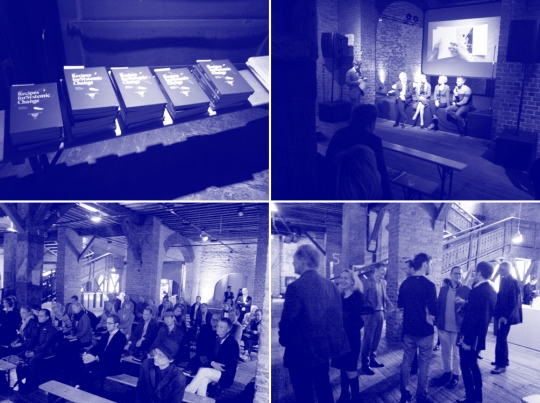
Colors changed to hide the fact that these were low resolution pics taken on a camera phone
On that note, if you're in London we will be in town this week for some meetings and are taking advantage of the opportunity to have a book launch there as well. See the Facebook page for details and please RSVP (soon!) if you would like to come.
As I was cleaning my desk I came across some sketches done in preparation for the book trailer video. We stayed pretty true to these thumbnails. Not bad for ideas drawn on a sick bag.
Enough with this book thing. Things continue apace on other endeavors. This includes work in-house that Dan and I are doing with our colleagues Olli and Tapio to prototype some of the working environments and habits we anticipate fostering in the eventual new offices which are part of Low2No. More on this soon.
It also means Justin, and to a lesser extent myself, spending late nights working on the new Low2No website which we will be soft launching soon. It should look familiar to readers of this blog.
Because three's a charm, another piece of great news came in for Low2No this week. The project has received an Acknowledgement Prize from the Holcim Foundation. Thanks to our partners at Arup, Sauerbruch Hutton, and Experientia are due as well for this.
Thursday morning while Marco was in Estonia presenting at the Nordic Council of Minister's Modern Eco-Cities conference, the rest of the team had breakfast with Joi Ito and Markko Ahtisaari.
Markko kindly invited us along to hear Joi give a talk at Nokia. Joi deftly connected many dots and it was a true pleasure to hear him talk about his plans for the MIT Media Lab, which he now directs. I'll keep this brief because the thoughts deserve a more careful bit of writing, but if there's one thing I took away from Joi's presentation it was this:
Because of the declining cost of doing things and increasing levels of complexity in the systems around us, it's often cheaper to prototype (and recover from potential failures) than it is to assess risk.
Update: Joi has posted about this on his website.
This dovetails nicely with some slow burn research we've been doing into what you might call 'cultures of decsion making.' Ultimately the ways in which we perceive, assess, and mitigate risk shape so much of what we allow ourselves to do. Likewise, the manner in which we anticipate, plan for, and recover from failure defines the outer limits of what we allow ourselves to reach for.
When we look at the rise of the open source software movement, agile project management, and the popularity of design these things add up to a new culture of decision making. The better we can coherently articulate the value of these approaches as ways to cope with the GFC and other black swans, the more likely we are to find a way through.
Or at least that's the hypothesis we're prototyping.
Perhaps the last thing we expected to do Thursday was end the day by moving 742 kilograms of paper, cardboard, and ink around Sitra HQ. But when a shipment arrives and the palette it sits on does not fit into the elevator, this is what happens. In other words, the book that we've been mentioning on this blog is finally here! Thanks to the helping hands of Seppo, who makes this building tick through his steady management of the front desk, we were able to get everything in from the loading dock in no time.
Inside were lots of these:
In Studio: Recipes for Systemic Change is a book about crafting vision. It's about how to take something big, messy, and complex and very rapidly begin developing a way to respond to the problem. It gives an introduction to the what and why of strategic design, documents the studios that we hosted last year, and then offers a practical "how-to" manual for hosting your own studio. Hop over to the book page and watch the trailer video.
Marco, Justin, and I are really honored to have a Foreword from Geoff Mulgan of NESTA and an Afterword by our very own Mikko Kosonen. These contributions put the work of Sitra's strategic design unit into the wider context of Sitra's activities as a whole, as well as the social innovation more broadly.
We have some launch events coming up and are looking forward to these as opportunities to meet old friends and hopefully also some new ones. If you've been following the blog or interested in Sitra's strategic design work it would be great to meet you. Please join us for one of the events in Helsinki or London.
Putting the book together has been an excellent—if sometimes grueling—opportunity to revisit the ways that we talk about our work. But it's also amazing the number of decisions put into motion by something seemingly as simple as "let's write a book". What began with documenting our work in a format that is easy to share, grew into a mess of micro projects that looks something like this:
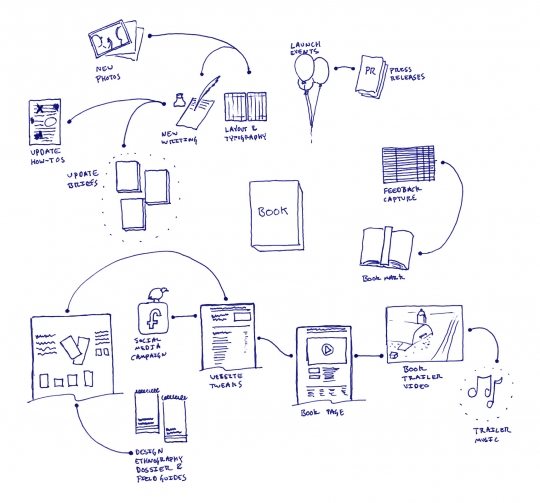
Sometimes a simple book is not so simple.
TwoPoints have done a stellar job with the physical object; we've tried our best to create a PDF that is as easy as possible to use (for instance, it has a hyperlinked table of contents); and Sitra Communications team have been doing bang-up job helping with the press stuff. Well done, everyone.
More pictures. Or in other words, this is where we fulfill Justin's dream of being a hand model.
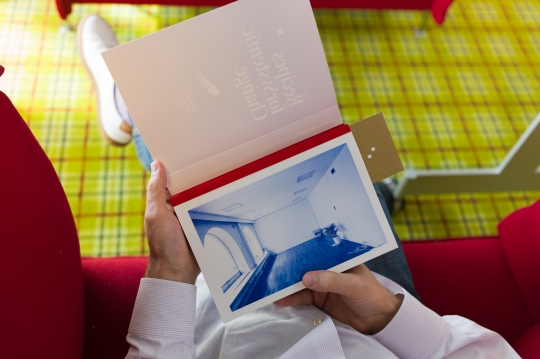
There's a cloth binding hiding inside.

All three Challenge Briefings from last year's studios have been refined and included here.

The bookmark is a thinly veiled attempt to solicit feedback.
To highlight some of the ancillary things we've been lining up before the book launch, there's a new dossier on design ethnography. This includes a "fieldguide" available in English and Finnish. It comes out of the Synergize Finland studios that we hosted earlier this year. We've also been adjusting this website to link up with Facebook, for instance, and to be more suitable for reading on an iPad and other tablet devices.
Onwards, onwards. If you're here in Helsinki enjoy Design Week and perhaps we'll see you around town.
We're still technically on holiday here until next week, but things are coming along with our book project so I thought I would share some pics from the process of bringing something to press.
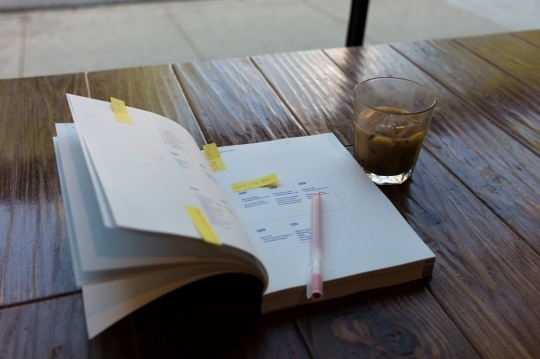
An early dummy. We used this to mark up all errors and changes.
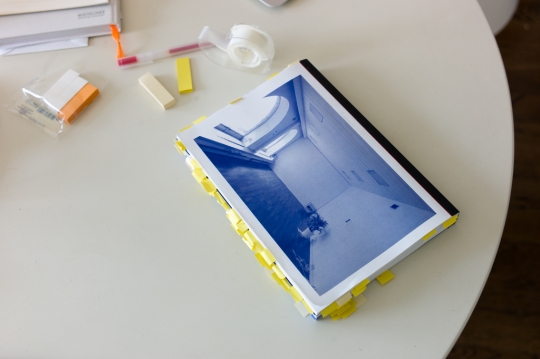
This is just after marking all of the changes and updates. There were a lot of things to fix.
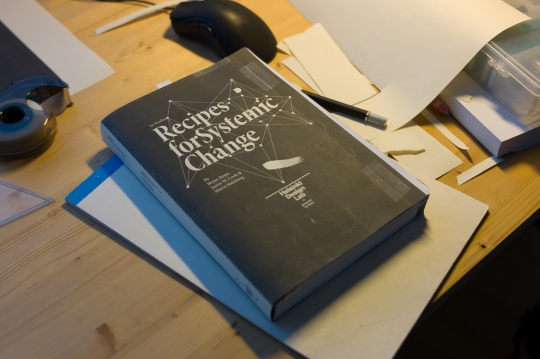
Mocking up the cover on a dummy book.

Plotters from the press. Testing ink distribution and other technical elements. Spotted a couple more issues to be resolved too.
Back next week with a real weeknote!
It's July so most of us are on vacation (along with the rest of Finland). Unfortunately publishing deadlines do not go on holiday, so we are still clocking in to work on the book. Getting there.
Well, that's something.
We did start the week with that conference call Dan mentioned, and it was good, but otherwise pretty quite around these parts. Justin and Dan are on holiday. I'm on partial holiday. And Marco has been out of the office at the Tällberg Forum.
Recommendation: Enjoy summer. Weeknotes will be thin now till August.
With Juhannus now days away, we're transitioning from a spring of spiky activity that came in high and rapid peaks to a mid-year that is more even-keeled. As Dan mentioned last time, this includes experiments in our collective workflow, such as new rituals involving the whiteboard.
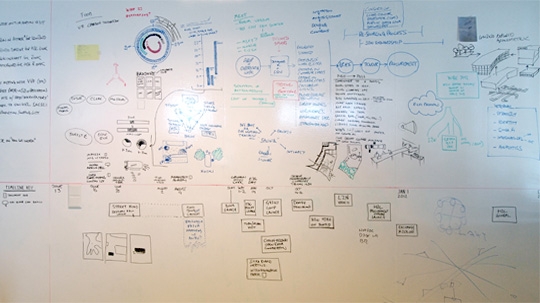
One week's worth of thoughts, notes, conversations, ideas, and misfires.
A couple balls rolling at the moment, all in different directions and each with their own pace. Marco, Justin, and Dan are each deep in their own corners of Low2No and I've been pitching in a bit here and there; our peek into the culture of street food in Finland continues; and we've been reflecting on and documenting our experiences as a cross-functional unit within Sitra. This last bit is part of a larger transition that is happening within our organization. So in addition to a lot of time spent at the board, we're also regularly whipping up one-pagers and trying to distill our experiences into easily digestible documents. As frustrating as it may be to constrain oneself to a single page, the discipline of brevity is a good and worthy challenge.
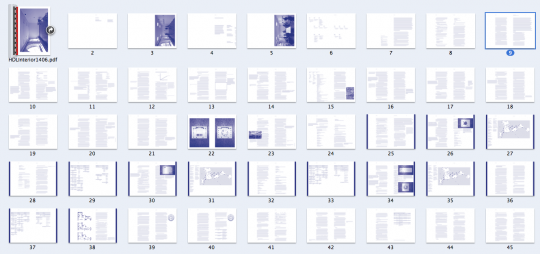
Draft book spreads. These are only a few days old and yet already things look much different.
And then there's the book. Now that we've organized and hosted a total of seven studies, our knowledge about how to do this sort of work is stabilizing. With interest about the Studio Model from Belgium to Brazil we decided that a 'recipe book' would be a good format to share some of our experiences (and hopefully insights)—so that's exactly that we're doing. After spending winter and spring writing, we're now in production. Editing, layouts, images, diagrams, and more. Martin at TwoPoints has been peppering us with questions about bindings and other arcana of bookmaking, which usually send us off into a small spiral of consideration before we come back with a decent answer. As these aspects calm down we are starting to think about electronic publishing. There is, quite frankly, a lot to do. So far it has been a relatively painless process. So far.
If you missed it, earlier this week we posted a slew of photos from the studios that we organized last month. Ivo shot in color this time so they look different. Last year was gritty chiaroscuro, but this year the images have an otherworldly lightness.
Over in Denmark, our friends at INDEX send word that they've posted the finalists for the 2011 INDEX: Prize. Congratulations to all of them—and good luck on the final round of competition.
And now that we have a healthy history of weeknotes we can do neat things like this: This was week 117, one year ago we were in Week 065. Moi Moi!
